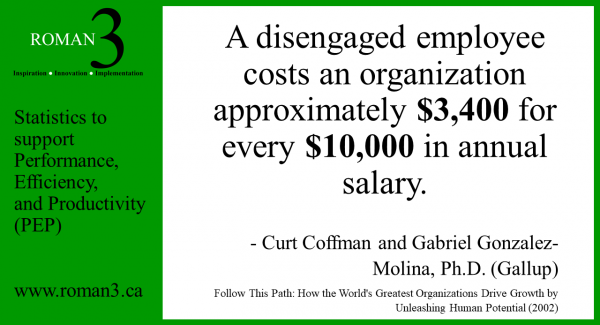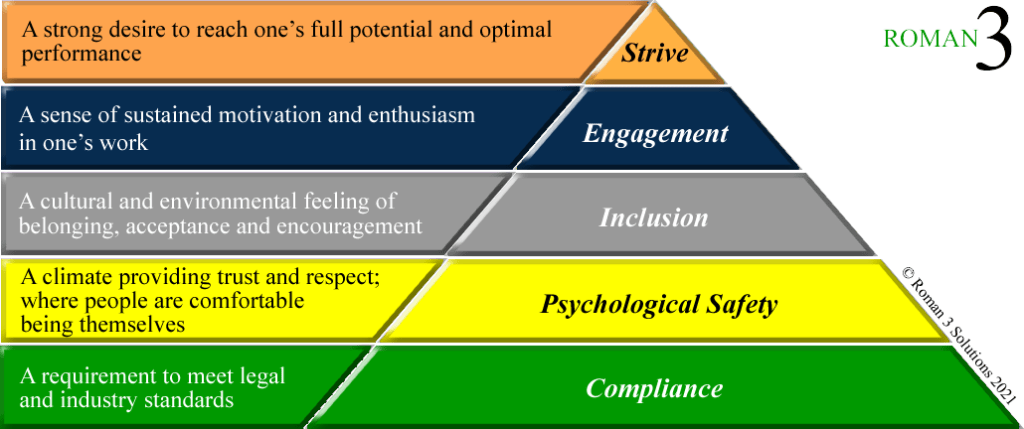- +1 902 932 7300
- Academy@roman3.ca
- Mon - Fri: 9:00am - 9:00pm
- 11 Opportunity Lane, Coldbrook Nova Scotia, Canada B4R 0A5
What is Employee Engagement
How do you create a highly motivated, productive, and engaged workforce?

By Roman 3 Academy
Table of Contents
What is Employee Engagement?
Employee Engagement is the effort organizations make to create a high level of motivation and enthusiasm in their employees. What those efforts are and how to know which efforts will produce the best results is the foundation of our research and training on the 4 Pillars of Engagement.
Many organizations look at Employee Engagement merely as a measurement tool, a piece of software they can install that will survey their employees and spit out results about how many staff are happy, stressed, engaged, fulfilled, and a host of other adjectives. These pieces of software can be incredibly valuable in providing insights into the current state of your workforce, however, more often than not organizations will stop with the data collection and never dive into what actually creates an engaged employee.
Before we delve into the 4 Pillars, let’s take a look at why Engagement is important in the first place.



How Employee Engagement Effects Your Bottom Line
There has been a lot research comparing businesses and organizations who place a great deal of effort in improving employee engagement with those who put in a moderate level of effort. The results from this research have created some astonishing statistics. Here are just a few examples:
Highly engaged workplaces saw 41% lower absenteeism, 17% increase in productivity, and 59% less turnover. This means that workers are showing up to work more reliably, working harder while they are at work, and are twice as likely to stay with the company rather than jumping ship.
When you look at the long term performance on metrics, such as; annual sales or production output, it is astonishing how much better organizations that put a high effort into employee engagement perform when compared with those who put in minimal effort. Those high engagement organizations outperform their low engagement competitors by over 200%.
One group that really notices when employees are engaged in their work, are the customers. In fact, often when we speak to business owners who are looking for customer service training, things like taking initiative without the boss having to watch them constantly, what they mainly mean is they want their staff to be more motivated in their jobs and more enthusiastic with customers. Highly engaged employees will create a better customer experience. Companies with engaged employees see 233% greater customer loyalty and a 26% greater annual revenue.
The thing about employee engagement is not just that there are a lot of perks to be gained from having engaged employees, it is that there is a major loss of revenue when employees are disengaged.
The average small business in North America loses $27,000 per year due to the 5 most common labor challenges. These 5 most common labor challenges are: Disengagement, Turnover, Presenteeism, Absenteeism, and a Bad Hire.
As you can see from one of the stats above, Disengagement alone can cost your business up to 34% of the annual salary for each employee who is disengaged! We call this loss of revenue due to the 5 labor challenges: Labor Value Loss.
If you would like more detail about how a lack of engagement hurts your bottom line we dive into this topic in our Rethinking Labor Costs: Increasing Profits and Productivity course.
The 4 Pillars of Engagement
The loss of revenue due to labour value loss can be staggering and the worst part is that you are already losing this money. If you’ve come to this page knowing that your organization is dealing with low engagement, suffers from presenteeism, absenteeism or other common labour issues, then we can guarantee you that your profits are being affected. This money flies out the window through losing productivity, losing customers, damaging your reputation, losing time, retraining, overtime, the list goes on. This is why you cannot afford to ignore labour issues, you are already paying for it, dearly.
The good news is that as we’ve already mentioned Employee Engagement practices are the best way to stop labour value loss. So, let’s finally answer the question: What is Employee Engagement and what are the 4 Pillars of Engagement?
As we stated above, Employee Engagement is the effort organizations make to create a high level of motivation and enthusiasm in their employees.
The 4 Pillars of Engagement are Recognition, Autonomy, Mastery, and Purpose, known as RAMP for short. By taking the time and committing to employee engagement through RAMP, you will end up with happier employers, higher performance, better customer service, and a lot more money in your pocket.
Let’s dig into The 4 Pillars of Engagement:
First is Recognition: This is how you show employees appreciation and recognize their talents and efforts. Recognition is universal, every single business can benefit from improving recognition.
The next is Autonomy. This is how you let your employees influence their work environment and allow them to find their most productive process. Autonomy, in one form or another, can be used in most workplaces, some will an easier time implement it then others.
Next is Mastery: This is how you develop and use the talent pool you have working for you. Mastery becomes exponentially important as the difficulty and complexity of the work grows, but all organizations can benefit from committing to mastery.
Last is Purpose: This is how you help your employee find and obtain motivation and meaning in their work. Purpose is becoming the single most important element to employee motivation and is essential in managing multi-generational workplaces.
Engagement and Workplace Culture
Human needs and motivations have been studied extensively for decades. The definitive theory on human needs is Abraham Maslow’s Hierarchy of Needs.
Maslow’s Hierarchy is an excellent model to use when looking for a new way to approach workplace culture. We need to identify the different stages that correspond to Maslow’s framework and build a concept that will allow managers and leaders to better understand how to create an effective and sustainable strategy. The goal is to build a workplace culture that will create high levels of employee engagement and sustain employee motivation.
Our team has crafted a new theory that successfully applies Maslow’s Hierarchy to today’s workplace.

You can learn more about the Workplace Culture Hierarchy here. For now it is important to understand that you won’t have sustained success at the higher levels if you have not taken the time to get your foundation in place.
In short:
- In order for a workplace to strive toward optimization, it needs to foster a sense of engagement.
- In order for a workplace to create engagement, it needs to create an environment of belonging and inclusion.
- In order for a workplace to nurture a culture of inclusion, it needs to provide a psychologically safe and respectful climate.
- In order for a workplace to create a psychologically safe space, it needs to meet acceptable compliance and industry standards.
This is equally relevant to the individual as it is to the workplace. In order for an employee to strive to become the best version of themselves, they need to be engaged, they to have a sense of belonging, they need to feel psychology safe, and they need to be provided an acceptable standard.
As stated it is possible to have some success without addressing issues at all stages, but that success is likely going to be short-lived and nearly impossible to reproduce. The benefit of the Workplace Culture Hierarchy is that it provides clear steps to creating a healthy and productive workplace culture.
The 4 Pillars and The Workplace Culture Hierarchy
We get into greater detail in our Rethinking Inclusive Workplaces: Creating Belonging and Engagement, however it is important to go over the basics of how the 4 Pillars of Engagement relate to the Workplace Culture Hierarchy.
Everything starts here at Stage 1: Compliance. This stage is where much of the HR procedures, labour laws, industry standards, and administrative processes are incorporated. This is where much of the work supporting equity in the workplace will land, like addressing equitable pay, and providing accommodations. This level also tends to be where most Human Resources work starts, and unfortunately stops. It is a critically important stage, since it is our foundation, but it is only the first stage. The bulk of the work to create inclusion and workplace culture happens beyond compliance. To learn more about how you can move beyond compliance check out our page on The 7X3 Rule.
Stage 2: Psychological Safety. This is without a doubt the most overlooked stage in the workplace. This is where all employees are provided an environment where they feel safe to express themselves and feel a sense of trust and mutual respect from the people they work with. This is where we need to feel safe to be kind, and not just be nice. It is at this stage, the factors that create Autonomy at Work become critically important. Autonomy is about creating rules that empower freedom. Rules that empower build trust and transparency in the workplace.
Stage 3: Inclusion. This is arguably the most important stage in creating a successful workplace culture. Stage 1 Compliance and Stage 2 Psychological Safety are specifically designed to lead you to inclusion. And Stage 4 and 5 are about leveraging the impact that inclusion offers to a workplace. At the inclusion stage is where we incorporate the factors that create Recognition at Work. It is about been seen as an individual and shown that you matter as an individual, not a number or as a job title.
Stage 4: Engagement. This is often the carrot that most workplaces see as being the motivation for changing workplace culture. Employee Engagement is arguably the single most important factor in the workplace. It has been proven time and time again to significantly increasing employee performance, talent attraction and retention, customer relations, and organizational profitability. It is the most important factor when exploring organizational change and cannot be overstated for its importance. This is the stage where incorporating the factors that create Purpose at Work become essential. Purpose is about inspiring and sustaining the sense of fulfillment that gets people out of bed in the morning.
Stage 5: Strive. This is where we as individuals strive to improve ourselves and our skills. And where our organization can strive to improve the performance of all employees. At the top of the hierarchy, employees are looking to become the best at what they do, their motivation has turned into ambition or the desire for self improvement. This is the stage where we incorporate the factors that create Mastery at Work. Mastery is about using your skills to their full potential and then seeking to become better at what you are already good at.
The Takeaway
Employee Engagement is so much more than a piece of software or surveys and we’ve only scratched the surface of answering the question of what is employee engagement. Explore the rest of our Knowledge Suite or the various courses referenced throughout this article to learn more about the topics discussed.
Want To Work With Us?
Book Your Free Consultation Today
You will receive a no obligation customized plan, tailored to meet your unique needs.
